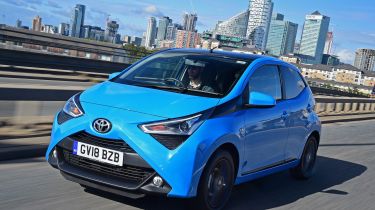Toyota Aygo (2014-2021) review
It’s stylish, fun, and cheap to run, but the Toyota Aygo faces some formidable rivals

The current Toyota Aygo isn’t all that mechanically different from its predecessor, but its looks are refreshingly contemporary with a youthful slant.
There’s not much power or dynamic capability, and while improvements to the sound-deadening make this a more refined car to be in at speed, it’s still some way short of the city car class leaders for motorway driving. Practicality also suffers thanks to the Aygo’s super-compact dimensions.
Yet the latest Aygo maintains the same sense of fun as before, and there are small but worthwhile technical improvements under the skin, including some significant advances in vehicle safety. Plus it’s super frugal, easy to personalise, and well-connected with Toyota’s latest x-touch multimedia system. So it may only earn three stars from us, but if you like it - you’ll love it!
About the Toyota Aygo
The Toyota Aygo was one of the first wave of sub-supermini-sized city cars that created the modern formula for compact, lightweight bodies designed to shoehorn in four adults, perky three-cylinder power and lots of scope for personalisation.
The first model arrived in 2005, and was manufactured alongside Citroen and Peugeot siblings in a joint venture factory built in the Czech Republic by Toyota and the PSA Group. Clever design, low running costs and cheeky looks made all three variants popular in markets around Europe.
Used - available now

2023 Tesla
Model 3
22,496 milesAutomaticElectric
Cash £21,400
2024 Cupra
Formentor
47,310 milesAutomaticPetrol1.4L
Cash £19,400
2018 Audi
Q2
67,400 milesManualPetrol1.4L
Cash £12,300
2021 Land Rover
Discovery Sport
27,561 milesAutomaticPetrol2.0L
Cash £25,300That first generation of cars was still being built almost ten years later, which is a mark of their success. The second generation is proving long-lived too, having been in production itself since 2014 - albeit with a facelift in 2018, which freshened up the looks along with a few small technical improvements.
While the Aygo’s longevity is admirable in some respects, it does mean Toyota isn’t able to offer an EV option, or even a hybrid. That’s an upgrade we’d expect to see in the third generation Aygo, but that’s not likely to appear before 2022, giving certain rivals a distinct head start.
Aside from its French stablemates, with which it shares much of its mechanical make-up, the little Toyota has a raft of popular rivals including the Fiat 500, Hyundai i10, Kia Picanto and VW up!
Although it was billed as a new replacement model, the Aygo Mk2 retained much of the engineering of its predecessor, including the 1.0-litre three-cylinder engine. However, the styling was freshened up considerably, with a bold new look said to be inspired by Japan’s manga comic art. The interior was much improved too, along with the cabin tech and connectivity.
While the Aygo continues to be built alongside new versions of the Peugeot 108 and Citroen C1, there’s greater visual differentiation between the brands. You can get manual and automatic gearboxes, both with five speeds, while the rest of the package is pretty conventional, including a front-wheel drive chassis with front MacPherson struts and torsion beam suspension at the rear. Brakes are discs up front, drums at the rear, and steering is courtesy of an electrically assisted rack and pinion set-up.
The Aygo range starts with the entry-level x-play trim which features 15-inch steel wheels, power-adjustable heated mirrors, body-coloured exterior trim, air-con and on-board tech such as smartphone integration, a DAB radio and Bluetooth.
Next is x-trend, which comes with 15-inch alloy wheels, coloured side sills and matching exterior highlights, automatic headlights, front fog lights and privacy glass. An x-trend bi-tone version is also offered, adding a black roof and extra coloured trim for around an extra £500.
The top x-clusiv model adds everything but the kitchen sink - albeit at a price. The specification includes a range of two-tone exterior paint options, smart entry, push-button start and automatic air conditioning.
Toyota isn’t shy of producing Aygo special editions, either. In 2017 it released the limited-run x-claim, which featured an electrically retractable roof and special decals, while in 2019 it launched the x-cite Mandarin, sporting bright orange paintwork with a contrasting black roof and orange interior trim highlights.
Engines, performance and drive
Owners of the previous-generation Aygo will feel at home behind the wheel of the Mk2 model. For starters, the 1.0-litre three-cylinder engine is carried over from the old car with small but significant tweaks, while an update in 2018 unleashed a heady 71bhp. Overall refinement is improved, but the engine retains the thrummy soundtrack and eager nature it had before.
You can hear it so clearly because Toyota has done a better job at dampening wind and road noise. It's better at motorway speeds, but still falls behind cars such as the Hyundai i10 and VW Up! for long-distance refinement and comfort. The retractable roof that’s available as an option on some models adds a bit in terms of wind noise, but it's better than you'd expect.
Steering that’s 14% sharper than the Mk1's makes the Aygo ideal for darting around town, although at higher speeds there’s significant body roll. The pay-off for that is a supple ride over bumpy roads.
The steering is light and accurate, the Aygo turns into corners keenly and there’s decent grip. Body movement is better controlled in some rivals, but the Aygo fared well during our braking tests. Letting the side down is the notchy and reluctant manual gearbox shift action, which oddly isn't as pleasant as the previous-gen Aygo's, even though it’s supposed to have been upgraded.
Engines, 0-60 acceleration and top speed
There's only one petrol engine available to Aygo buyers, but luckily the 1.0-litre VVT-i unit is an enthusiastic performer that’s happy to rev, filling the cabin with a characterful three-cylinder noise. While some will find it intrusive, others will like the rorty tone. Indeed, Toyota engineers say positive customer feedback about engine noise in the previous Aygo focused their minds on reducing road and wind noise, specifically so the engine – without getting any louder - could be heard better.
The pleasing tone is fortunate, as particularly long first and second gear ratios mean you need to rev the engine hard to produce power. But there’s plenty of performance for nipping around town and the revision in ratios means the engine does feel less strained at a sustained fast cruise, compared to its predecessor. The Aygo’s 71bhp is developed at 6,000rpm, and 93Nm of peak torque is delivered at 4,300rpm.
The x-shift automated manual has slightly shorter gear ratios, so feels as though it picks up speed quicker around town – it blips the throttle on downshifts, too. The official performance figures show that the extra power is worthwhile, with the Aygo managing 0-62mph in 13.8 seconds, a whole four-tenths of a second faster than the previous generation car. Maximum speed is 99mph.
Technical upgrades over previous versions of the 1.0 engine are focused on better combustion efficiency, reduced internal friction and exhaust gas flow optimisation. That means you get a new cylinder head with slightly higher compression, plus an exhaust gas recirculation system and freer-flowing catalytic converter among other detail changes.
MPG, CO2 and running costs
Although the 1.0 VVT-i is fundamentally the same unit as used by the Toyota Aygo’s predecessor, it has been re-engineered for the current model. A higher compression ratio of 11.5:1, a new low-friction timing chain and a cylinder head with built-in exhaust manifold to save weight have all helped to improve fuel efficiency and cut emissions.
The mods allow Toyota to boast of raising the engine’s thermal efficiency (the amount of the fuel’s energy it converts to power) to a class-leading 37%. That’s impressive, but it’s a cautionary thought that even in an economy-minded city car like this you’re losing 63% of the energy in your petrol tank to (mainly) waste heat and friction. And that’s in those rare moments when the engine is running at peak efficiency.
Still, the numbers aren’t too bad. Toyota claims a maximum fuel economy of 56.4mpg for the five-speed manual model, with CO2 emissions from 114g/km. while the auto returns up to 54.3mpg and 119g/km of CO2.
Insurance groups
Perhaps the implied ‘youth’ appeal of its zingy styling makes a difference, but it’s more likely to be design details like those relatively expensive projector headlamps that mean the Toyota Aygo will cost you more to insure than some of its more staid-looking city car rivals.
However, Toyota has included its Safety Sense pack as standard for the latest Aygo range, which means all cars are in group six for insurance.
By way of contrast the entry-level Hyundai i10 starts the bidding off with an impossible-to-beat insurance group one, while the Skoda Citigo, VW up! And SEAT Mii all undercut the Toyota’s group ratings too.
Depreciation
With Toyota expecting to sell a quarter of all European Aygos here in the UK, there isn’t likely to be a shortage of used models on the market. The Aygo is expected to retain around 39% of its original list price after three years and 36,000 miles.
To get an accurate valuation on a specific model check out our free car valuation tool...
Interior, design and technology
Toyota has taken a bold approach with the Aygo, ditching the old car’s soft curves and rounded details in favour of sharp edges and eye-catching angles. Highlights include the swept-back headlamps, rising window line and tall tail-lights. The double-bubble roof panel is particularly eye-catching.
The car certainly looks more distinctive than the Skoda Citigo-e iV, SEAT Mii Electric and VW up! but the Citroen C1 and Peugeot 108 are similar and their clean-cut lines will be more attractive to some.
The same youthful approach continues inside, where there’s a gloss black dash finish and a large touchscreen infotainment system, plus a circular steering column-mounted pod that houses the speedo, digital fuel gauge and rev readouts. Yet while it appears modern and is solidly screwed together, the hard plastics on the dash and doors look and feel fairly cheap. Those details are mainly noticeable because the cabin as a whole is so much more sophisticated than the old car's - the penny-pinching trim predictably stands out.
The big draw compared to rivals like the VW up! and Hyundai i10 is the funky design inside and out, and the level of personalisation available on the Aygo. The Japanese hatch is emblazoned with a distinctive ‘X’ running from the A-pillars to the front grille – just one of a number of parts that can be swapped around in a variety of colours.
There’s the allure of an optional (x-trend trim only) retractable cloth roof for around £895, too, and Toyota’s x-touch smartphone-optimised infotainment system brings it bang up to date. Buyers can change the colour of the ‘X’, wheels and rear bumper, as well as a selection of snap-in interior parts. It’s a tactic designed to attract young, fashionable customers to the brand, and proves Toyota is trying to put an era of bland designs behind it.
Sat-nav, stereo and infotainment
There are no complaints about the standard kit list, with all cars benefiting from air-con, a DAB radio and Bluetooth. A real highlight is the x-touch multimedia system, which features an intuitive set-up that pairs quickly with a smartphone.
Better still, if you’ve got an Android device, you can use the Mirrorlink function to duplicate your phone’s menus and graphics on the Toyota’s touchscreen. All versions feature steering wheel audio controls, while the JBL Edition brings an upgraded audio system.
Practicality, comfort and boot space
The Aygo is slightly longer, wider and lower than the Mk1, so looks a little less truncated from some angles, even though it has an identical wheelbase.
Only available as five-door model, the side glass design extends to meet the rear light clusters giving a sense of added length. Unfortunately it’s an illusion, and you shouldn’t be surprised to learn that rear seat passenger comfort is not a strength in the Aygo.
There are a pair of three-point seat-belts in the rear for adults, but no space for a third, while a pair of Isofix child seat mounts is standard in the back, too.
The news is better up front, where the driver sits relatively high up with a good view out. There’s a reasonable range of adjustment on the seat and steering wheel – although not quite enough for taller drivers, who may struggle to get comfortable.
There are two cup holders, a good-sized glovebox and door bins big enough to hold a 500ml bottle of water.
Dimensions and size
The Aygo is a very compact car, so it's perfectly at home in the city where its dimensions make it a breeze to thread down side-streets and fit in even the smallest parking spaces.
It’s actually a few mm longer than the previous generation – 25 to be exact – but 5mm lower. The front and rear tracks have been widened by 8mm to improve the stance, and while the wheelbase is the same as before at 2,340mm, Toyota has still managed to find an extra 9mm of cabin space. It’s still a smidge shorter than a Hyundai i10, but the trade-off in lost practicality is evident the moment you need to carry passengers or put luggage in the boot.
Leg room, head room & passenger space
Front headroom has improved slightly, despite the lower roofline thanks to a curved ‘double-bubble’ roof and front seats lowered by 10mm. However, the small side windows at the back and high-backed front seats make the rear feel claustrophobic and legroom is seriously restricted even for smaller passengers. Rivals like the Hyundai i10 feel significantly roomier. The five-door model makes things easier for rear passengers to get in and out at least.
The £850 'x-wave' option brings an electrically retractable folding fabric roof that slides back to the rear headrests in around 10 seconds, or bunches up halfway to act as a sunroof. If you look below the roofline, however, the Aygo's lines – and more importantly its passenger accommodation - are unaffected.
Boot space
The Aygo makes the most of its compact dimensions with a deep but narrow boot that’s 29 litres bigger than its predecessor's at 168 litres – it's just about enough for a couple of suitcases or a set of golf clubs.
It will be fine for many owners’ purposes, but if cargo capacity is your main consideration, the Aygo does lose out badly to the Hyundai i10 and VW Up, both of which offer capacities north of 250 litres.
The design isn’t ideal either as there’s a fairly high lip between the boot floor and your luggage, and the rear seats – with optional split fold – don’t even lie flat, instead leaving an awkward step.
Reliability and safety
The Aygo has slipped down the Driver Power customer satisfaction rankings over the last few years - from 39th in 2017, to 90th in 2019, out of 100 cars. It managed 60th place in 2021, on a 75-car list, while Toyota itself moved up to 5th spot in the best manufacturers poll - up from 6th position in 2020.
Euro NCAP awarded the Aygo a four-star rating (out of five) for safety in 2017. This was with the Safety Sense kit fitted, and led to scores of 82% and 63% for adult and child occupant protection, respectively.
All versions of the Aygo get four airbags, Isofix child seat mountings, stability control and tyre pressure monitoring, along with other safety tech such as a lane-departure alert and a pre-collision system.
Warranty
The Toyota Aygo comes with a five-year warranty - and a 100,000 mileage limit – that will bring valuable piece of mind to anyone considering holding onto their car for a while. The offer beats the Citroen C1 and Peugeot 108 by two years, in spite of the fact they’re built in the same plant.
Toyota also offers a strong three-year paint defect warranty, and 12 years anti-corrosion cover – although you’d need to be dedicated to keep the dealer inspections up to date that long.
Servicing
The Toyota Aygo requires a major service every 20,000 miles, with a first intermediate service at 10,000 miles and at subsequent 10k intervals in-between the majors.
The fixed price dealer services are around £100 and £180 respectively, and you can pay up front using one of the dealer service plans, or even spread the cost with monthly instalments.



